
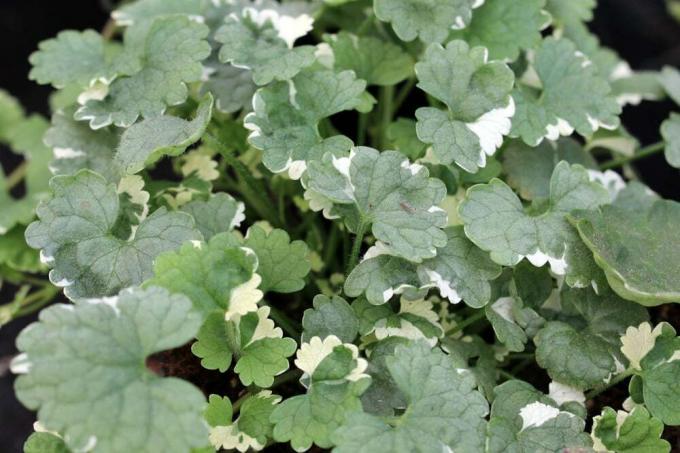
Table of contents
- Occurrence and identification features
- fungal diseases
- causes
- combat
- Systematic approach
- Mechanical emergency measures
- changing soil conditions
- Preferred site conditions for the Gundel vine
- Measures
- weed killer
- Application
- liquid products
- Combination products with fertilizer
- Security
- toxicity
- Conclusion
Ground ivy (Glechoma hederacea), also known as ground ivy, is a perennial plant that produces small purple flowers. It is widespread in Europe and has oval to heart-shaped leaves. If ground ivy grows in the lawn, this represents not inconsiderable competition for the grasses in terms of water, light and nutrients. Hidden in the lawn, close to the ground, the ivy grows about 15 cm high and forms long runners. This allows the perennial plant to spread widely.
Occurrence and identification features
Ground ivy belongs to the mint family (Lamiaceae) and grows as wintergreen, herbaceous plants. Their shoots crawl along the ground as spurs with a square cross-section and can reach a length of up to two meters. Rooted nodes form every ten centimeters on average. The ground ivy has only shallow roots, its flowering shoots grow upright between 10 and 20 cm high. The bluish-purple flowers form in the axils of the heart-shaped leaves and are only about one to two millimeters in size. When fertilized, small nut fruits ripen between June and July, which also contribute to the propagation of the conquering herb.
As pretty as the dainty plant may look, unfortunately it quickly becomes a nuisance in the lawn. Because the ground ivy is not content with just one spot in the garden, but quickly spreads through its foothills. In turn, independent plants can develop from the rooted nodes, which in turn form offshoots. This creates a dense mesh in the lawn in a relatively short time. Areas that cannot be reached by the runners are by no means safe from the weed, as ants carry the seeds to remote corners of the garden. In this way, the plant manages to conquer large parts of the lawn in a short time and increasingly crowds out the grass.
fungal diseases
However, the ground ivy is not only unpopular because it crowds out other plants and competes with them for nutrients and light. It also has another unpleasant quality: it is very susceptible to various fungal diseases such as mildew and rust. It can transmit these pathogens to neighboring plants.
causes
Lawns should be as free as possible from weeds. This is not just a visual matter, but an indication of healthy, strong weed with strong roots. If earth ivy settles in the lawn, this is a sign of a disturbed balance. Possible causes include:
- Soil permanently damp (shady location, compacted soil, drainage problems)
- the lawn is not cared for enough (cut too short, not scarified regularly)
- the nutrient content is not optimal
- the pH of the soil is not optimal
- gaps in the lawn
If the grasses in the lawn are weakened, the robust ground ivy can settle and multiply undisturbed. In order to permanently remove the annoying weeds, it is therefore important to create optimal conditions for the lawn.
combat

Once the ground ivy has spread, it can usually only be eliminated by regular weeding. Luckily, the perennial plants are quite easy to pull out of the ground by hand. Basically, the ground ivy is very annoying if you want to have a well-groomed lawn, but otherwise it is not necessarily a problem. The creeping plant hardly poses a threat to healthy grass areas. However, the ground ivy can become quite rampant if the grass does not form a closed hub. Frequent lawn mowing does not bother the weeds. On the contrary, this measure encourages its growth even more. The earth ivy reacts sensitively to frequent walking on it. It is therefore mainly found in places where there is little "traffic".
Systematic approach
Ground ivy is a very persistent plant. If remnants remain in the soil, new plants will grow from them and the plague will start again after a while. A single measure is not enough to drive these weeds out of the lawn permanently and effectively. Control is most effective when the gardener is systematic and uses a combination of different methods.
Mechanical emergency measures
As long as the ground ivy does not get out of hand in the lawn, you should limit yourself to purely mechanical methods. You can usually keep the plant under control quite well this way. In the case of strong propagation, however, this method represents a considerable effort, especially when it comes to large lawns. Nevertheless, it is necessary to first remove a large part of the weeds by hand (possibly with a rake), even in the case of severe infestation.
- Time: all year round, preferably before seed ripening
- otherwise you will also have to take care of the seedlings
- can be weeded relatively easily because of the shallow root system
- It is best to start with the mother plant
- First loosen heavy soils with the digging fork
- take out the rosette
- then pull out the spurs
- alternatively remove it with a rake
- additionally scarify
If you can't find the mother plant, gently pull on a stolon. Since these always spread from a node (main plant), the runner inevitably leads you to the origin of the plant at some point. The challenge lies in not overlooking any parts of the dense vegetation, because this can in turn form new plants.
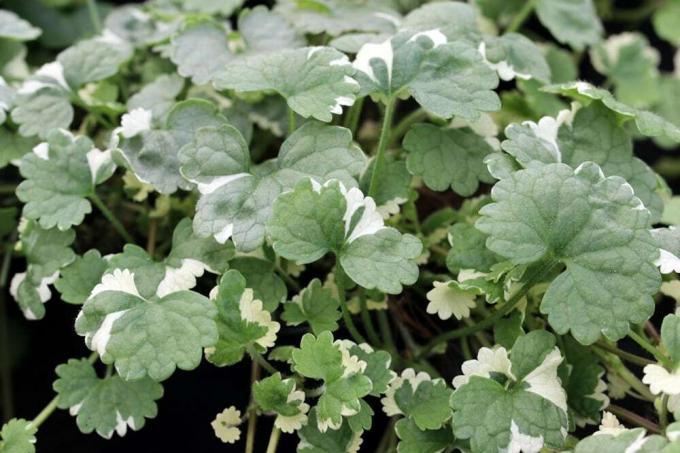
Tip:
Remove grass clippings immediately after mowing. But do not dispose of it in the compost, otherwise the ground ivy may spread further in the garden. The lawn should not be cut shorter than about four centimeters.
changing soil conditions
Although a large part of the ground ivy has been removed after the manual processing of the lawn, this does not mean that it will remain so permanently. If the same conditions prevail in terms of location and soil conditions, the unloved plant will return after a short time. If you create optimal conditions for the grasses, weeds will have a hard time gaining a foothold. Gundelrebe is not serious competition for healthy, strong grass.
Preferred site conditions for the Gundel vine
Glechoma hederacea prefers certain site and soil conditions in order to settle and spread widely. It is considered an indicator plant for the following conditions:
- light shade
- slightly damp
- heavy soil
- nutrient-rich (high nitrogen, phosphate and calcium supply)
- calcareous
- also grows in slightly acidic soil
Measures
As with many lawn weed problems, a long-term approach to control begins with a critical assessment of the lawn's site and soil conditions. In most cases, favorable conditions for the rampant weeds mean unfavorable conditions for the grasses. A combination of shade, wet soil and few nutrients works in favor of the weeds. For this reason, in the future it is necessary to adhere to a few important rules. Basically, the earth ivy can probably not be completely banished from the lawn. However, with a few simple tricks, its spread can be limited.
- Scarify the lawn regularly
- Do not cut grass too short (minimum length 4-5 cm)
- Work in some sand or grit on heavy soils (immediately after scarifying)
- avoid very shady areas next to/under dense hedges and trees
- Possibly cut back shrubs a little (provides more light)
- Close gaps in the lawn with lawn seed
- sow a more shade-tolerant turf variety in shady locations
- Optimize soil pH
- on light soil: pH 6.0
- on heavier soils: pH 7.0
You should also fertilize your lawn regularly. The nutrients do not help to drive away the ground ivy, but strengthen the grasses so that no other weeds settle in them. However, be absolutely careful not to introduce high levels of nitrogen into the soil, otherwise you will become an involuntary breeder of ground ivy.
Tip:
Before applying fertilizer or changing the pH with lime or other means, you should send a soil sample to a laboratory and work on the result. In specialist shops, there are sets for sending in from as little as 20 euros.
weed killer
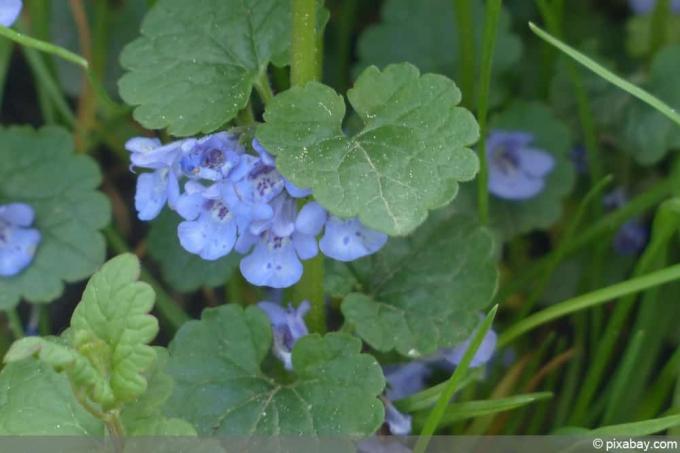
One way to remove ground ivy from your lawn is to use weed killers that are specially designed for grassy areas. Treatment is carried out either by spraying or pouring with the shower attachment. Only lawn weed killers may be used on the lawn. The reason for this is that the herbicides or combination products made from fertilizer and weed killer can differentiate between weeds and grasses, so there is no need to fear damage to the lawn. Whether the product is also effective against ground ivy is noted in the instructions for use or the package insert. If in doubt, seek advice from a specialist when purchasing, so that incorrect use can be ruled out.
- Application period: May to October (preferably in spring or autumn)
- are only effective against dicotyledonous plants
- Grasses are monocot plants
- always follow the instructions on the package carefully
- multiple applications may be necessary
Most of the active ingredients in the herbicide are absorbed through the leaves, and a small part through the roots. The active ingredients are thus distributed throughout the plant and systematically damage it. After a standstill in growth, the entire harmful plant eventually dies.
Application
Lawn weed killers are commercially available in ready-to-use form (usually in a spray bottle) or as a concentrate that must be diluted with water before use. The product is then either sprayed directly onto the ground vines or poured using a watering can with a shower attachment. Warm but not too hot weather conditions accelerate the death of the ground ivy. While the effects kick in after just a few hours, it only becomes visible a few days later when the plants die and turn brown.
In order for the weed killers to be effective, there must be enough leaf mass. Of course, the leaves of the weeds were also removed from lawns that had just been mowed, so that the agents cannot have a sufficient effect. Instead, wait a few days after mowing before applying the products.
liquid products
- apply to dry plants
- ideally it should not rain for at least 6-8 hours after the treatment
- use preferably in the evening
- Dew or rainwater leads to undesired dilution
- pay attention to intensive wetting of the leaves
- the finer the jet/nozzle, the better the wetting
- Minimum temperature: about 10 degrees
- Maximum temperature: around 25 degrees
- when spraying, only work on windless days
Combination products with fertilizer
- unlike liquid products, the leaves must be dewy
- possibly water a few hours before use
- alternatively apply after a rain shower
Dead plants should be removed from the lawn with a rake after a few days. However, never dispose of the plant remains in the compost or in the organic waste, but in the residual waste. Wear gloves when working to avoid contact with herbicide residues.
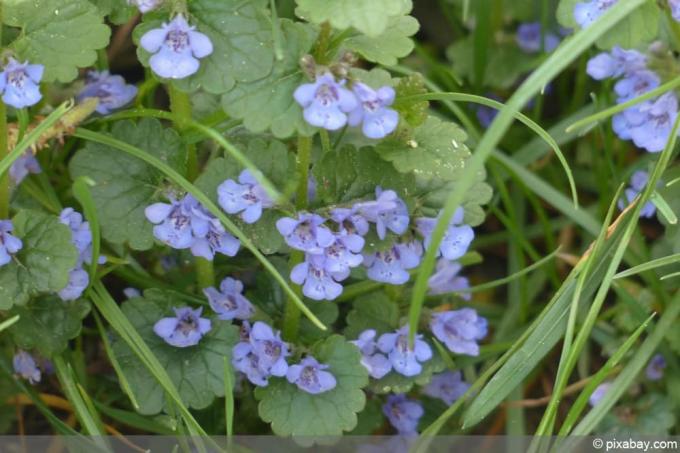
Security
Even if many of the herbicides are declared as organic, they can pose a risk if handled incorrectly. It is therefore essential to pay attention to your safety while using the herbicides.
- Keep children and animals indoors during treatment
- wear gloves
- Wear protective clothing (long pants, long sleeves, closed-toe shoes) during the spraying process
- safety goggles or even a face shield may be necessary
- do not work in strong winds or temperatures above 25 degrees
- Do not breathe spray mist
- Watering liquid or mist must not get onto neighboring ornamental or crop plants
- Keep distance to bodies of water
Tip:
The lawn area may only be walked on after it has dried. If you want to use the lawn as a lawn or play area, you have to wait until the lawn is next cut.
toxicity
While the ground ivy is considered edible for humans in small quantities and is also used as a medicinal plant, it is poisonous for many mammals. If you set up an outdoor enclosure for your rodents or rabbits on the lawn in summer, make sure in advance that it is free of ground ivy.
Conclusion
Once the ground ivy has settled in the lawn, you can never really get rid of it. Even herbicides will at best be temporary unless the conditions that originally led to the establishment of the unwanted weed are altered. A combination of weeding with a sensible use of herbicides is one of the most effective and environmentally friendly methods.
 garden editorial
garden editorial I write about everything that interests me in my garden.
Learn more about weed control

Combat field horsetail - this is how you destroy it permanently
The field horsetail is a dreadful terror for many gardeners because it spreads quickly and can infest large areas. In addition, the weeds can only be controlled with great effort and are relatively difficult to remove permanently.

Fight stinging nettles - this is how you destroy nettles permanently
With their vehement urge to spread and painful stinging hairs, stinging nettles spread fear and terror in the garden. So that the weeds in the bed do not develop from extras to protagonists, they should be fought at an early stage. This guide explains the best strategies to get rid of nettles permanently.
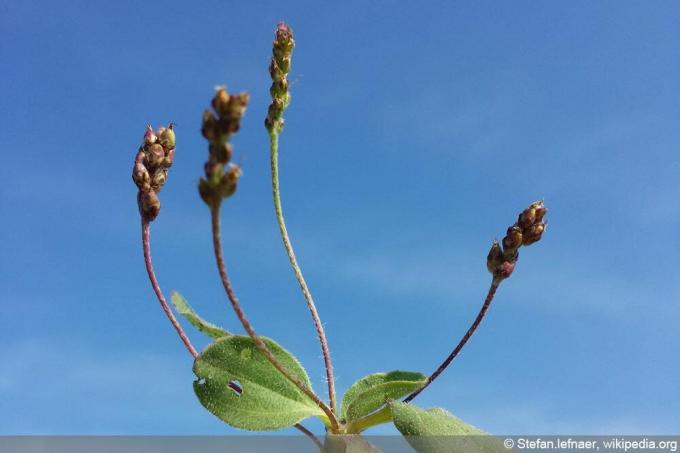
Combat plantain - combat weeds
Although plantain is known as a medicinal plant, it is very unpopular as a weed in well-tended gardens. It spreads rapidly, and there is suppression of shallow-rooted plants and grasses. With the right approach, plantain can be permanently removed in a number of ways. The home garden guide explains how to do this.

Combat Gundermann in the lawn - can you scarify it?
The ground ivy (Glechoma hederacea) is a wonderfully flowering ground cover, but as a weed it does not stop at well-kept lawns. It proliferates over the lawn at breakneck speed and is not that easy to remove. But with the tips and the professional instructions from the home garden guide, it works reliably.
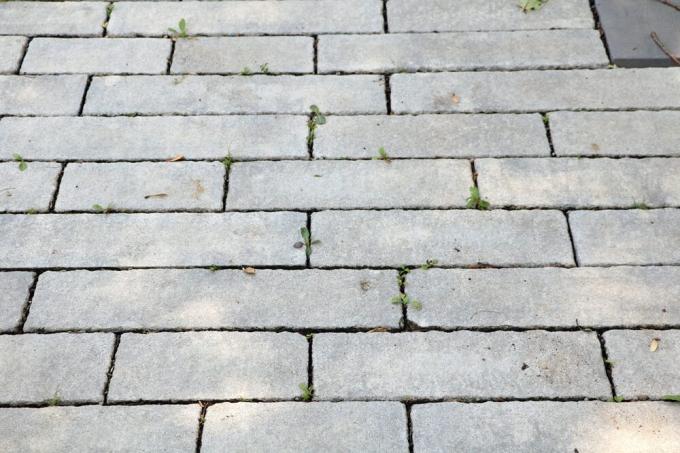
Weeds in paving stone joints – 12 effective weed killers
While weeds are welcome in an overgrown garden, among paving stones it creates an unsightly and unkempt sight. There are some effective ways to kill weeds, but the law does not allow them to be used on all paved surfaces. The professional home garden guide provides information and lists effective weed killers.
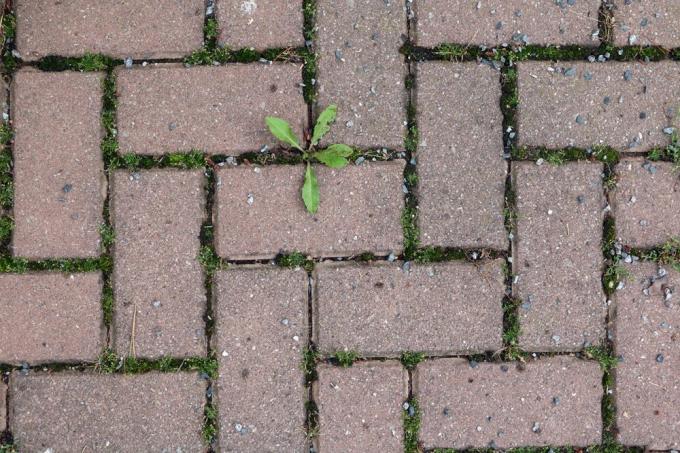
Burning weeds properly - is burning forbidden?
One of the most environmentally friendly methods of destroying unwanted weeds is scorching. Since the use of chemical weed killers is prohibited on paths and paving stones, flaming is particularly suitable here. You can find out here how you can burn weeds quickly and efficiently in the future.


